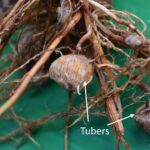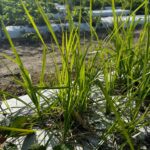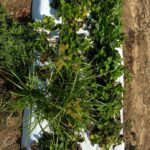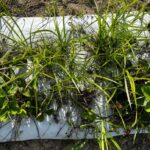Common names: Yellow nutsedge, yellow nutgrass, nut sedge, chufa, earth almond, northern nutgrass
Latin names: Cyperus esculentus L.
Family: Cyperaceae (Sedge family)
General Description
Perennial sedges are among the most troublesome weed species globally. Because nutsedges look like grasses (Figure 1), they are often referred to as “nutgrasses”. They can be differentiated from grasses by looking at their stems. Grasses have round or flat stems, but nutsedges have triangular stems (Figure 2). They typically reproduce through tubers, which can remain viable for up to 10 years. However, they are also capable of reproducing by seeds. From April to mid-July, tubers begin to sprout, and seedlings start to emerge. Nutsedges can also be propagated by underground stems called “rhizomes”. They frequently thrive in well-drained, sandy soils as well as in wet locations.
- Figure 1. A yellow nutsedge plant taken from a strawberry field. Photo by J. Cerritos.
- Figure 2. Nutsedge stems are triangular in cross-section. Photo by J. Cerritos.
Identification and Biology
Several nutsedges species exist, however the most common and troublesome ones are yellow nutsedge (Cyperus esculentus L.) and purple nutsedge (Cyperus rotundus L.). Both are perennials that spread asexually through rhizomes (Figure 3). These rhizomes extend from the mother plant to form new shoots or tubers. Tubers are initially rounded, ridged, and white, but they gradually turn brown and black (Figure 4). They form at the ends of rhizomes and can be found within the top 6 inches (15 cm) of the soil profile. These tubers overwinter in the soil and once conditions are favorable, they break dormancy and sprout. Yellow nutsedge leaves are yellow-green, have a long, tapered point and grow in clusters (Figure 5).
- Figure 3. The structure of a yellow nutsedge plant. Photo by S. Meyers.
- Figure 4. Yellow nutsedge tubers. Photo by S. Meyers.
- Figure 5. Yellow nutsedge plants growing on plasticulture strawberries. Photos by J. Cerritos.
Yellow and Purple nutsedge
They are often mistaken for each other due to their similar appearance. However, yellow nutsedge has yellow-green leaves with leaf blades that come to a sharp point. In contrast, purple nutsedge features deep green leaves that end in an abrupt point (Figure 6). The inflorescence (or flower structure) of yellow nutsedge is straw colored, whereas the inflorescence on purple nutsedge is reddish-purple (Figure 7). In Indiana, yellow nutsedge is far more common.
- Figure 6. A purple nutsedge leaf (left) and yellow nutsedge leaf (right). Photo by S. Meyers.
- Figure 7. Floral structures of purple (left) and yellow nutsedge (right). Photo by S. Meyers.
Management
Yellow nutsedge can be a challenging weed to control due to its ability to reproduce easily through various propagation methods. Nutsedges can significantly impact crop yield through several mechanisms. They compete with crops for essential resources such as light, water, and nutrients. Additionally, nutsedges exhibit allelopathic effects, releasing chemicals that inhibit the growth and establishment of crops, further reducing overall yield. The strategies that can be deployed will vary with the crop being grown and your production system.
Sanitation and Exclusion:
Because nutsedge can reproduce through plantlets, rhizomes, and tubers, it is important to remove visible nutsedge parts and soil before moving ground-engaging equipment from nutsedge infested fields to those without nutsedge (Figure 8).

Figure 8. Nutsedge plants hang on the back of a sweetpotato harvester and can easily be moved within or between fields without proper sanitation. Photo by S. Meyers.
Mechanical Control:
Cultivation and hand-removal are only effective short-term solutions. Nutsedges can regrow if the plants are not entirely removed, including both the stems and root systems. Cultivation is most effective when performed on small nutsedges that have not yet developed tubers and have underdeveloped root systems. Repeated mechanical tillage can help suppress nutsedge, but there is a risk of spreading the plants and tubers to other fields via the equipment.
In some fruit crops, plastic mulches are used for weed control. However, these mulches do not fully suppress yellow nutsedge, as the plants can grow through the plastic (Figure 9).
- Figure 9. Yellow nutsedge plants grow through white plastic mulch in a strawberry field. Photos by J. Cerritos.
- Figure 9. Yellow nutsedge plants grow through white plastic mulch in a strawberry field. Photos by J. Cerritos.
Biological and Cultural Controls:
Interestingly, yellow nutsedge tubers are particularly palatable to some animals. In fact, yellow nutsedge marketed as “chufa” is sold to wildlife food plot enthusiasts for turkey. It is said that hogs will root in the soil for the tubers as well. Unfortunately, for perennial fruit crops, the utility of wild or domesticated animals to reduce yellow nutsedge population is impractical.
If your cropping system permits, summer cover crops can be an effective option, as they compete with nutsedge for light, water, and nutrients, which ultimately help to reduce its spread. This may mean cover cropping between rows for tree fruits or after the final harvest of a strawberry patch coming out of production. Choose cover crop species that grow quickly and/or that will grow above the nutsedge canopy. Buckwheat and sorghum-Sudan grass are two common choices, but others will work as well.
Herbicides:
Herbicide options for fruit crops are limited compared to agronomic crops, primarily due to the risk of crop injury and the pre-harvest interval (PHI), which is the required minimum time between pesticide application and crop harvest. However, when available, chemical control using herbicides with active ingredients like sulfentrazone, halosulfuron, and S-metolachlor can help manage these weeds effectively. Soil-applied herbicides should be sprayed and incorporated before nutsedge emerges. If the label allows it, sequential applications of postemergence herbicides 2 weeks apart can increase nutsedge control compared to a single application. Unfortunately, grass-selective herbicides such as clethodim and sethoxydim do not control nutsedges. Yellow nutsedge is a persistent weed that may require multiple herbicide applications for effective control. Always read the label and follow approved rates and guidelines for application. Consult the Midwest Fruit Pest Management Guide (https://ag.purdue.edu/department/hla/extension/_docs/id-465.pdf) for more information about herbicides registered in the fruit crops you grow.
References
Meyers, S. L., & Shankle, M. W. (2015). Nutsedge Management in Mississippi Sweetpotatoes. Mississippi State University Extension. https://extension.msstate.edu/sites/default/files/publications/publications/p2909.pdf
Neal, J.C., Uva, R.H., DiTommaso, J. M., DiTommaso, A. (2023). Weeds of the Northeast. Second edition by Cornell University.








